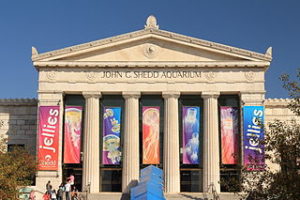How Can Museums Be More Accessible? Ask the Community.
by Beth

The Shedd Aqaurium in Chicago, Illinois.
Last Thursday I sat on a panel at Chicago’s Shedd Aquarium with a theater director, a mother of three school-aged children, and a lawyer.
Theater director Brian Balcom uses a wheelchair, one of Laurie Viets’ children is on the autism spectrum, attorney Rachel Arfa is profoundly deaf and uses bilateral cochlear implants to hear, and then there was me, with Whitney the Seeing Eye dog at my feet. What do we all have in common? We enjoy going to plays, to concerts, to museums.
The four of us were there to talk with staff from a variety of departments at the Shedd (from VPs to senior directors to facilities staff) about ways museums and cultural institutions can be welcoming to all visitors — including those of us with disabilities.
Some of the ideas we shared were new to the audience, others served as good reminders.
We played well off of each other, and one staff member said afterwards that we’d shared information they would have never considered. “Even though when I thought about it, the idea was really just common sense.” A few examples:
- Brian said he’d love to be able to join with others at the Shedd’s Touch pool exhibit and feel a stingray or sturgeon fish, but the way the touch tank is mounted you have to be able to stand up and reach over to get your hands in the water. “You have stools there for the kids to use, but I can’t stand on a stool.”
- Rachel said she’d been to the Dolphin Show at the Shedd but without audio captioning she wasn’t able to take it in the way others did.
- Laurie said taking breaks at quiet areas can help avoid meltdowns in museums, but when at a museum for the first time, she doesn’t always know where those quiet areas are.
- For my part, I said I don’t mind at all when people ask me if I need help, but I like to know who’s offering.
Brian pointed out that a lot of kids come to the aquarium. “How old are kids when they’re this high?” he asked. I pictured him in his chair, placing his palm on the top of his head. “Seven or eight? When you’re planning new exhibits, maybe you could arrange everything so a kid who’s seven or eight can see it, that way anyone using a wheelchair should be able to access it, too.”
Rachel encouraged them to use audio captioning with all their shows and videos, noting that some older adults who are hard of hearing like audio captioning, too.
Laurie suggested signage and maps that mention where the quieter areas of the museum are.
I said I’m more comfortable accepting assistance if I know the person asking is someone on staff. “I can’t see your uniform, though,” I reminded them. “So if you think of it, introduce yourself before you ask.”
Our presentation occurred right smack dab in the middle of spring break week in Chicago, and the aquarium was p-a-c-k-e-d with kids. Eyebrows up! Instead of sitting at home watching TV, the kids were all learning how important the waterways are to us, and to the creatures who live there. Bonus: the Shedd Aquarium gifted all four of us with free passes to visit when it isn’t so crowded. Can’t wait to get my hands on one of those stingrays!
Read how one of these panelists helped designed an accessible rally






